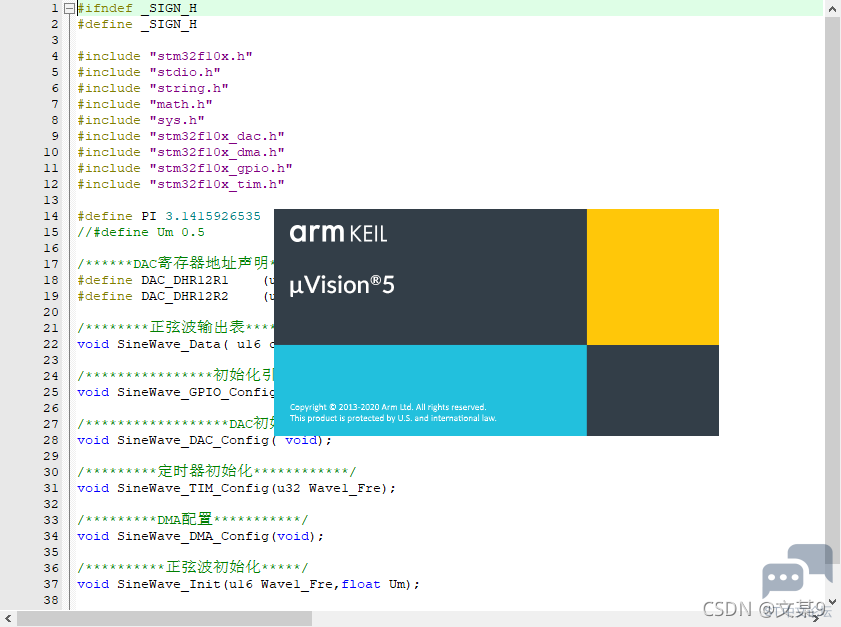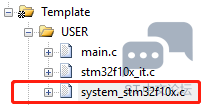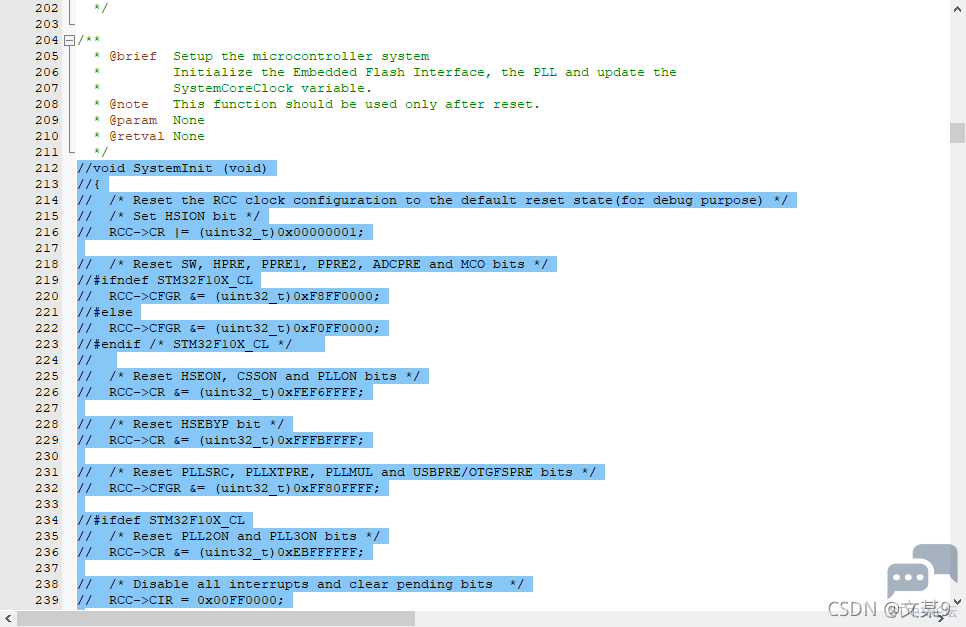首先说明一下芯片内部并没有时钟, 而是内部振荡。
使用内部振荡的好处是外部无需设计晶振电路 ,再说的简单点 ,不用外部晶振依然可以让单片机正常运转。
书归正传 直接开始配置
打开任意keli工程

打开system_stm32f10x.c

找到systeminit函数 全部注释掉

然后在下面粘贴以下代码(这段代码来自CSDN的一位大佬,我不是原作者)
直接替换就可以用了
- #define USE_HSI 1 // 是否使用内部晶振 0 不使用 1使用
- void SystemInit ( void )
- {
- #if USE_HSI
- {
- //设置使用内部晶振
- /* 开启HSI 即内部晶振时钟 */
- RCC->CR |= ( uint32_t ) 0x00000001;
- /*选择HSI为PLL的时钟源HSI必须2分频给PLL*/
- RCC->CFGR |= ( uint32_t ) RCC_CFGR_PLLSRC_HSI_Div2;
- /*PLLCLK=8/2*9=36MHz 设置倍频得到时钟源PLL的频率*/
- RCC->CFGR |= ( uint32_t ) RCC_CFGR_PLLMULL6; //设置倍频后的频率
- /* PLL不分频输出 ?*/
- RCC->CFGR |= ( uint32_t ) RCC_CFGR_HPRE_DIV1;
- /* 使能 PLL时钟 */
- RCC->CR |= RCC_CR_PLLON;
- /* 等待PLL时钟就绪*/
- while ( ( RCC->CR & RCC_CR_PLLRDY ) == 0 )
- {
- }
- /* 选择PLL为系统时钟的时钟源 */
- RCC->CFGR &= ( uint32_t ) ( ( uint32_t ) ~ ( RCC_CFGR_SW ) );
- RCC->CFGR |= ( uint32_t ) RCC_CFGR_SW_PLL;
- /* 等到PLL成为系统时钟的时钟源*/
- while ( ( RCC->CFGR & ( uint32_t ) RCC_CFGR_SWS ) != ( uint32_t ) 0x08 )
- { }
- }
- #else
- {
- //设置使用外部8M晶振
- /* Reset the RCC clock configuration to the default reset state(for debug purpose) */
- /* Set HSION bit */
- RCC->CR |= ( uint32_t ) 0x00000001;
- /* Reset SW, HPRE, PPRE1, PPRE2, ADCPRE and MCO bits */
- #ifndef STM32F10X_CL
- RCC->CFGR &= ( uint32_t ) 0xF8FF0000;
- #else
- RCC->CFGR &= ( uint32_t ) 0xF0FF0000;
- #endif /* STM32F10X_CL */
- /* Reset HSEON, CSSON and PLLON bits */
- RCC->CR &= ( uint32_t ) 0xFEF6FFFF;
- /* Reset HSEBYP bit */
- RCC->CR &= ( uint32_t ) 0xFFFBFFFF;
- /* Reset PLLSRC, PLLXTPRE, PLLMUL and USBPRE/OTGFSPRE bits */
- RCC->CFGR &= ( uint32_t ) 0xFF80FFFF;
- #ifdef STM32F10X_CL
- /* Reset PLL2ON and PLL3ON bits */
- RCC->CR &= ( uint32_t ) 0xEBFFFFFF;
- /* Disable all interrupts and clear pending bits */
- RCC->CIR = 0x00FF0000;
- /* Reset CFGR2 register */
- RCC->CFGR2 = 0x00000000;
- #elif defined (STM32F10X_LD_VL) || defined (STM32F10X_MD_VL) || (defined STM32F10X_HD_VL)
- /* Disable all interrupts and clear pending bits */
- RCC->CIR = 0x009F0000;
- /* Reset CFGR2 register */
- RCC->CFGR2 = 0x00000000;
- #else
- /* Disable all interrupts and clear pending bits */
- RCC->CIR = 0x009F0000;
- #endif /* STM32F10X_CL */
- #if defined (STM32F10X_HD) || (defined STM32F10X_XL) || (defined STM32F10X_HD_VL)
- #ifdef DATA_IN_ExtSRAM
- SystemInit_ExtMemCtl();
- #endif /* DATA_IN_ExtSRAM */
- #endif
- /* Configure the System clock frequency, HCLK, PCLK2 and PCLK1 prescalers */
- /* Configure the Flash Latency cycles and enable prefetch buffer */
- SetSysClock();
- #ifdef VECT_TAB_SRAM
- SCB->VTOR = SRAM_BASE | VECT_TAB_OFFSET; /* Vector Table Relocation in Internal SRAM. */
- #else
- SCB->VTOR = FLASH_BASE | VECT_TAB_OFFSET; /* Vector Table Relocation in Internal FLASH. */
- #endif
- }
- #endif
- }
然后我简单拉高/低是试了一下引脚的电压 是正常的 大家可以去试试
————————————————
版权声明:文某9
如有侵权请联系删除
|




 微信公众号
微信公众号
 手机版
手机版
